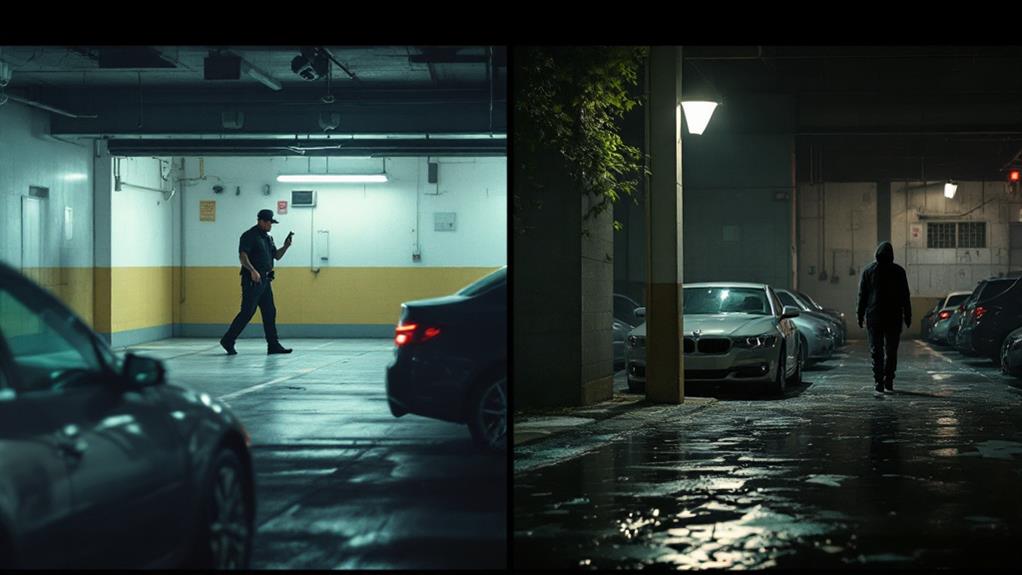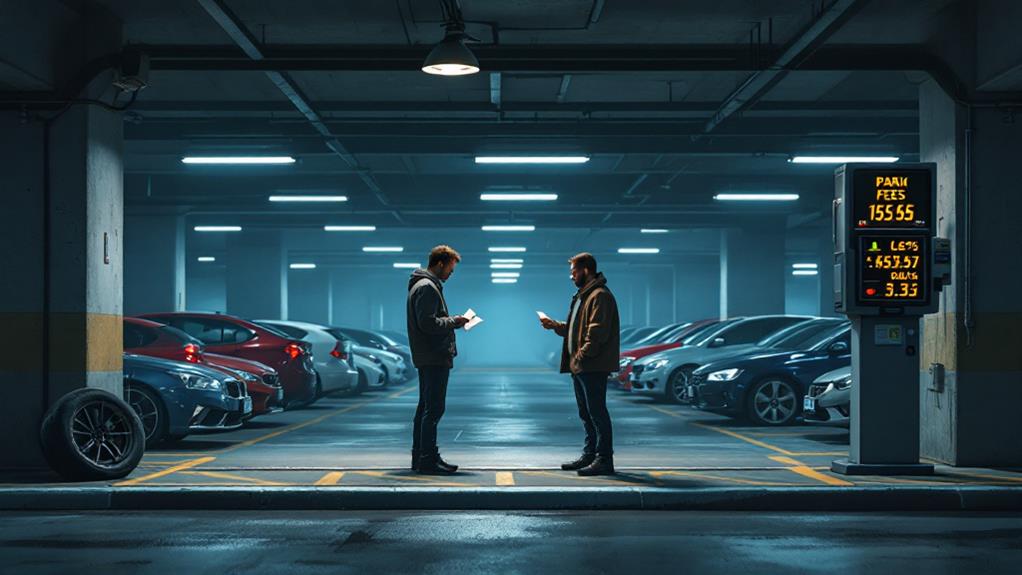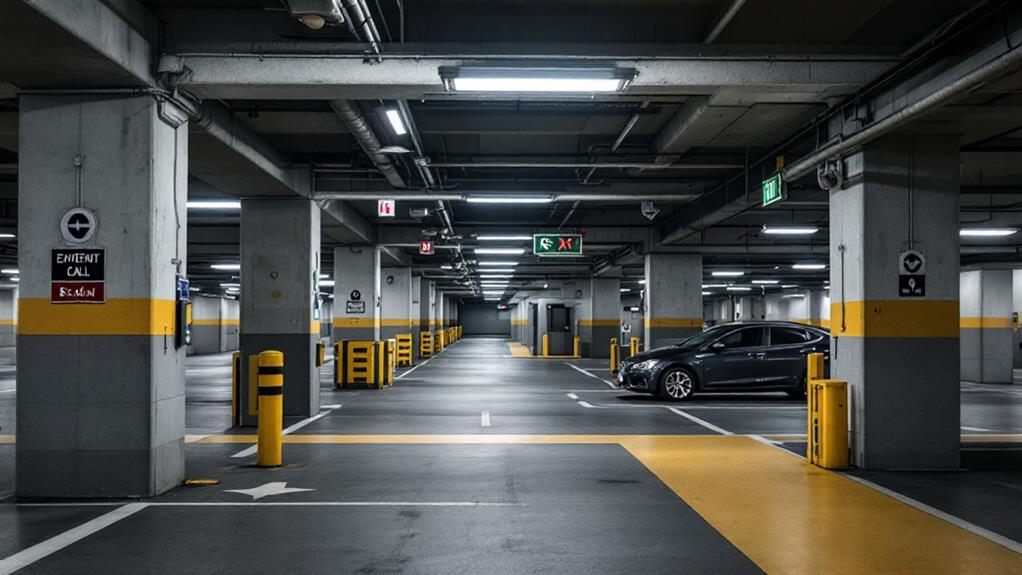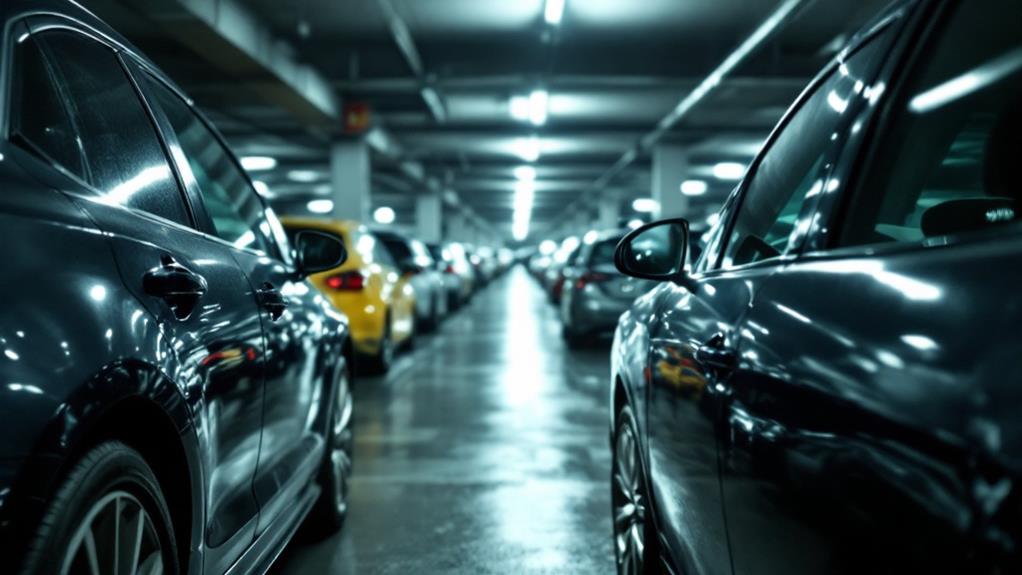Public Garage Etiquette: What Every Driver Should Know
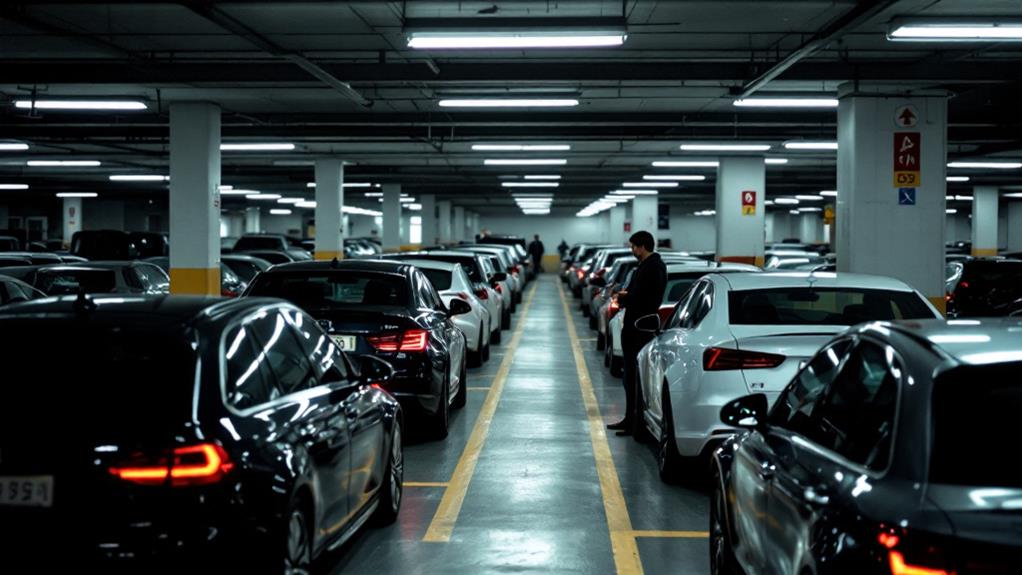
When parking in a public garage, you'll want to follow proper etiquette for everyone's safety and convenience. Park between the lines, respecting designated spaces, and use turn signals appropriately. Drive slowly and cautiously, always being mindful of pedestrians who have the right-of-way. Follow one-way traffic patterns and avoid blocking other vehicles. Be considerate by keeping noise to a minimum and maintaining proper distance from other cars. When exiting your parking spot, do so carefully to prevent accidents. By becoming proficient in these basic courtesies, you'll contribute to a smoother, more pleasant experience for all garage users. There's more to learn about maneuvering public parking structures efficiently and politely.
Park Between the Lines
The painted lines in a parking garage are your guideposts to courteous parking. When you enter a parking spot, make sure your car is evenly positioned between these lines. This not only shows respect for other drivers but also guarantees you'll have enough space to comfortably enter and exit your vehicle.
As you park your car, aim to center it within the designated area. This means avoiding any overlap into adjacent spaces or straddling the lines. By doing so, you're maintaining the intended capacity of the garage and preventing inconvenience to others.
When positioning your vehicle, consider how it will affect passenger access and cargo loading. Park in a way that allows doors to open fully without hitting neighboring cars. Also, think about visibility. A well-parked car should be easily seen from various angles, enhancing safety for pedestrians and other drivers.
Respect Designated Spaces
Respecting designated spaces in a public garage is critical for maintaining order and fairness. When you enter parking lots and garages, it's essential to park only in designated parking spaces. Avoid the temptation to occupy multiple spots, even if the garage isn't busy. This guarantees that everyone has an equal opportunity to find a place to park.
Always pay attention to signage and floor markings that indicate space limitations and restrictions. These guidelines are in place for a reason, often related to safety or specific needs of other drivers. Don't park in spaces reserved for particular uses, such as electric vehicle charging stations or handicapped access spots, unless you're authorized to do so.
To respect designated spaces, center your vehicle within the marked lines. This considerate act maximizes the available space for others and prevents unnecessary inconvenience. Additionally, be mindful not to block access aisles, fire lanes, or entry and exit points. By following these simple rules, you'll contribute to a smoother traffic flow and a more pleasant experience for all users of the parking facility.
Use Turn Signals Appropriately
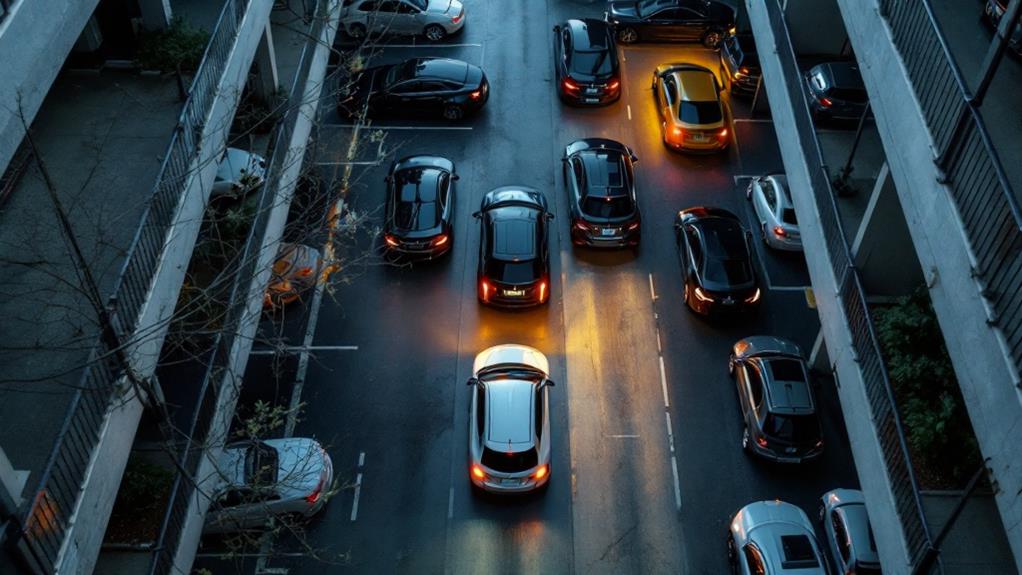
Within the confines of a public garage, proper use of turn signals is paramount. When you're approaching an available parking spot, activate your turn signal to alert other drivers of your intention. This simple action helps maintain the flow of traffic and reduces potential conflicts in the garage.
Don't forget to signal when you're exiting a parking space as well. This courtesy informs other drivers of your movements and allows them to anticipate your actions. If you notice another driver signaling to park in a space you currently occupy, yield to them and find another spot.
Patience is key in public garages. If you've spotted a desirable parking space, activate your turn signal and wait your turn. Respect other drivers who may have been waiting before you, and avoid aggressive maneuvers to secure a spot.
Drive Slowly and Cautiously
While signaling is important, your speed and caution are equally vital in a public garage. When navigating these crowded lots, it is necessary to drive at a slow, cautious pace. Maintain a speed below 10 mph to safely maneuver through tight spaces and allow for quick reactions. This reduced speed helps you avoid potential collisions and fender benders that are all too common in these confined areas.
As you drive through the garage, be extra vigilant for pedestrians, other vehicles, and obstacles. Anticipate the movements of drivers and pedestrians to proactively avoid hazardous situations. Remember, people may unexpectedly appear from behind parked cars or around blind corners.
Slow down even further when approaching areas with limited visibility, such as entrances, exits, and tight turns. These are high-risk zones where accidents are more likely to occur. By reducing your speed, you'll have more time to react to sudden changes in your environment.
Ultimately, driving slowly and cautiously in a public garage isn't just about following rules—it's about ensuring the safety of everyone in the lot, including yourself. Your patience and attentiveness can prevent accidents and create a smoother experience for all.
Be Mindful of Pedestrians

Pedestrians take center stage in public garage safety. As a driver, it's your responsibility to prioritize their well-being in this busy parking lot environment. Remember that pedestrians always have the right-of-way, so you must be prepared to yield and slow down when approaching walkways or crossing areas.
Keep a watchful eye for people emerging from between parked cars, as they may suddenly appear in your path. Be ready to stop and allow them to cross safely. When entering or exiting the garage, exercise extra caution, as pedestrians might not be visible until the last moment.
Avoid making abrupt movements, such as sharp turns or sudden stops, which could put nearby pedestrians at risk. Instead, maintain a slow, steady speed throughout the garage. This approach is especially vital in areas with limited visibility, where you need to be extra vigilant.
Follow One-Way Traffic Patterns
One-way traffic patterns are a fundamental aspect of public garage safety and efficiency. When you enter a parking garage, it's pivotal to follow these designated routes to avoid collisions and maintain a smooth flow of vehicles. Always obey posted directional signs and arrows, ensuring your car is traveling in the intended direction.
Driving against the one-way pattern can create dangerous situations for yourself and other drivers. You might unexpectedly encounter another car head-on, disrupting traffic flow and potentially causing accidents. By adhering to the one-way system, you help prevent gridlock and keep vehicles moving in an organized manner.
Before entering the garage, take a moment to familiarize yourself with the one-way routes. This preparation will help you traverse smoothly and safely, avoiding confusion or last-minute maneuvers. Remember, your actions affect everyone in the garage. By following the one-way traffic patterns, you contribute to a safer environment for all drivers and pedestrians.
If you find yourself unsure about the correct direction, it's better to pause and reassess rather than risk driving the wrong way. Always prioritize safety and be considerate of other drivers sharing the space with you.
Avoid Blocking Other Vehicles
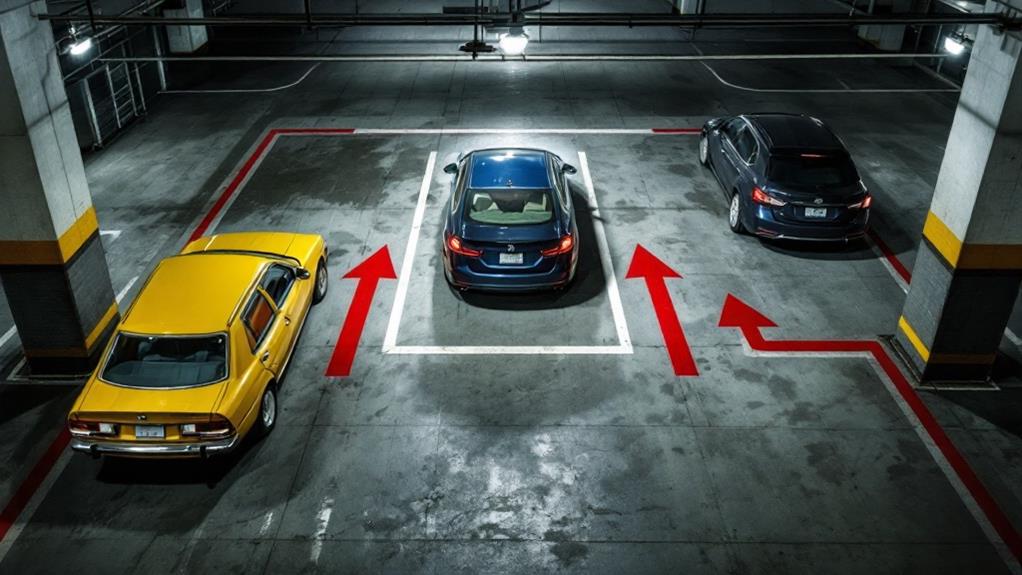
Blocking other vehicles in a public garage is a surefire way to create frustration and inconvenience for fellow drivers. To maintain a harmonious parking environment, you must be mindful of how your vehicle affects others. Always park within the designated lines of your spot, ensuring you're not encroaching on adjacent spaces. This consideration allows room for another vehicle to park comfortably next to you.
When traversing in the garage, be aware of your surroundings. Don't park in a way that prevents other vehicles from entering, exiting, or moving freely. Pay special attention to access aisles, fire lanes, and loading zones – these areas must remain clear at all times. If you're driving a larger vehicle, take extra care to position it properly, allowing ample space for others to maneuver around you.
Before leaving your spot, check for pedestrians and other vehicles. Pull out slowly and carefully to avoid potential collisions. Remember, your actions directly impact the parking experience of others. By following these guidelines, you'll contribute to a more efficient and stress-free parking environment for everyone using the public garage.
Keep Noise to Minimum
Echoing through the concrete structure, excessive noise in public garages can quickly become a nuisance for everyone. To maintain a peaceful environment, you should always park with consideration for others and be ready to leave quietly, especially in a crowded garage.
Avoid unnecessary honking, engine revving, or playing loud music. These sounds can be amplified in the enclosed space, disturbing other drivers and nearby residents. When you're closing your car doors, do so gently to prevent slamming noises that can startle others or create echoes throughout the garage.
Keep conversations with your passengers at a low volume. The acoustics in parking structures can carry voices further than you might expect, potentially disturbing others. Use your vehicle's horn sparingly, only when it's necessary to alert other drivers during low-visibility maneuvers.
If you enjoy listening to music in your car, be mindful of the volume. The enclosed space can amplify sound, so what seems reasonable inside your vehicle might be disruptive to others. By following these simple guidelines, you'll contribute to a more pleasant experience for everyone using the public garage.
Maintain Proper Distance
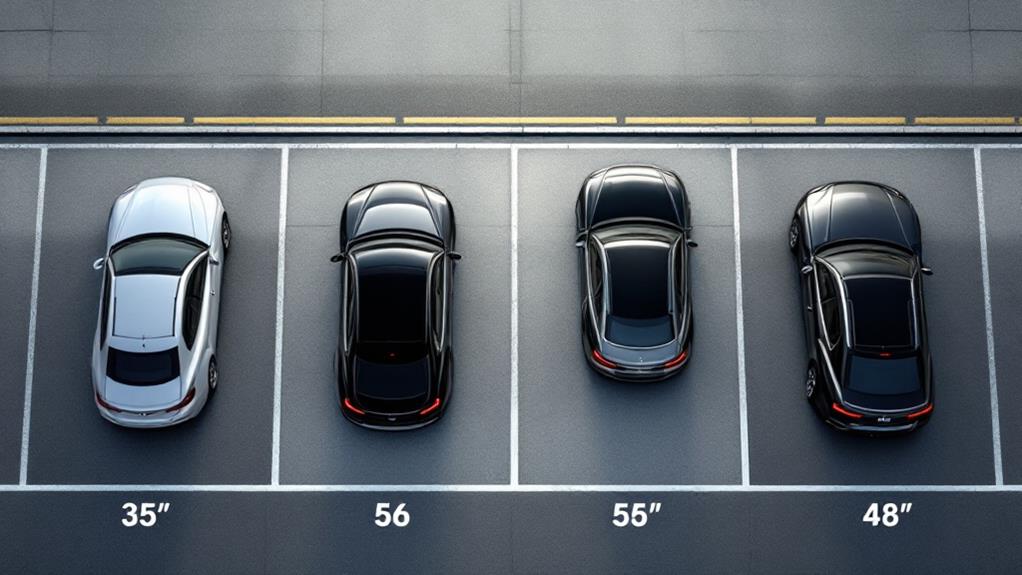
Safety and courtesy go hand in hand when traversing public garages. One vital aspect of driver education for parking garages is maintaining proper distance between vehicles. As you negotiate these confined spaces, remember to allow at least a car length of space between your vehicle and others when driving or stopping. This practice guarantees ample room for maneuvering, especially around tight turns.
When queuing to enter or exit the garage, keep an even, safe distance from other cars. This not only prevents accidents but also helps maintain a smooth flow of traffic. As you follow other vehicles, maintain a safe distance to ensure you can stop in time if the car ahead brakes suddenly. Avoid crowding or tailgating other drivers, as this behavior can lead to accidents in the confined garage environment.
Exit Parking Spots Carefully
Exiting a parking spot in a public garage requires as much care as maintaining proper distance while driving. When you're ready to leave, start by straightening your wheels before slowly backing out. This simple step improves your visibility and maneuverability, making it easier to facilitate the tight spaces of a public garage.
Before proceeding, check for pedestrians, oncoming traffic, and other vehicles in your blind spots. Remember, people waiting for a parking spot might be nearby, so stay vigilant. Use your turn signals to indicate your intention to pull out, showing respect for other drivers and helping them anticipate your movements.
As you exit, move cautiously and at a low speed to avoid potential collisions. Be mindful of car doors opening unexpectedly and create enough space for other vehicles to pass safely. Your careful approach not only guarantees your safety but also contributes to a smoother flow of traffic in the garage.
